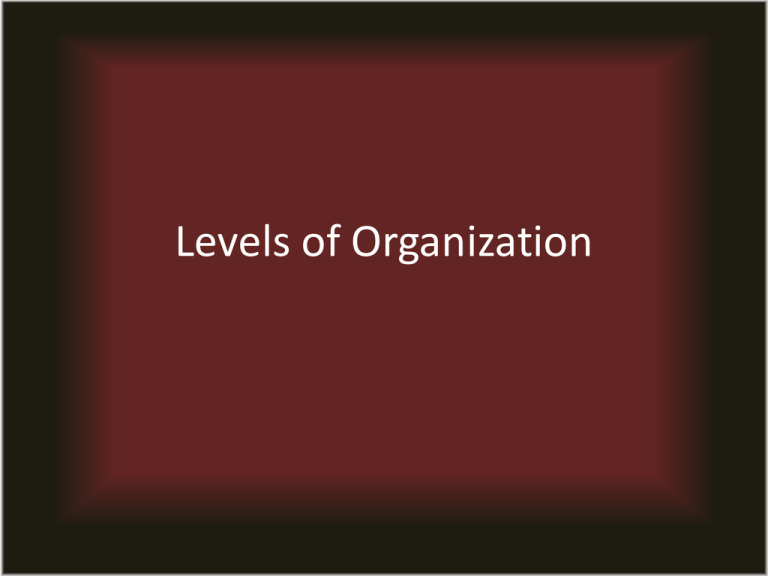energy
advertisement

Levels of Organization Factors • Biotic Factor - living environment, including all organisms • Abiotic Factor - nonliving/physical environment • Limiting Factor- something an organism needs to survive that is in short supply – i.e. Food, Water, Space What is Biotic? Abiotic? Levels of Organization • • • • • • Biosphere Biome Ecosystem Community Population Individual Levels of Ecological Organization • Individuals • Populations: Members of the same species that live together in the same area at the same time. • Communities: All the populations of different species that live and interact together within an area at the same time. What is in our biological community? Levels of Ecological Organization Continued . . . • Ecosystems: Community together with it’s physical environment. (Biotic and Abiotic components) What is in our ecosystem? Levels of Ecological Organization Continued . . . • Biome: A large area that has a particular climate, and particular species of plants and animals that live there (tundra) Levels of Ecological Organization Continued . . . • Biosphere:All the earth’s organisms and their interactions with each other, the land, the water, and the atmosphere. Individual Population Community Ecosystem Biome Biosphere Activity • In your groups: – Use the Continent that was assigned to you. – Come up with a pyramid showing the levels of organization that would be seen on your continent. • You may use your cellphones/laptops/etc to research information – Make a mneumonic BBECPO • DUE 9/18-19 Flow of Energy and Matter ENERGY • *The basis of every organism’s interaction with the environment is its need for ENERGY to power life’s processes • Organisms are classified by how they get energy: – Autotroph – Heterotroph Autotrophs (producers) 1. chemoautotrophs- use chemical energy (inorganic molecules) to produce sugars Ex: sulfur bacteria 2. photoautotrophs- use light energy to convert carbon dioxide and water into oxygen and sugars (glucose) Ex: cyanobacteria, algae, plants Chemoautotrophs Photoautotrophs (Bacteria, Algae, and Plants) Cyanobacteria (Bacteria) Algae (Protist) Plants Algae (Protist) Heterotrophs • Organisms that rely on other organisms for their energy (have to eat food or absorb it) 1. Herbivores 2. Carnivores 3. Omnivores 4. Detritivores 5. Decomposers Energy Flow in an Ecosystem Exchange of materials (Energy & Nutrients) Food Chains • Feeding of one organism upon another in a sequence of food transfers • Represents the transfer of energy in an ecosystem • (Sun) Rose plant Aphids Beetle Chameleon Hawk Food Webs • Many different food chains in an ecosystem are cross-linked to form a web Trophic levels • Feeding positions in a food chain/web – Producers (autotrophs) – Consumers (heterotrophs) • Primary Consumer – Herbivore • Secondary Consumer – Carnivore/Omnivore • Tertiary Consumer – Carnivore/Omnivore Ecological Pyramids • Shows trophic levels and flow of energy or matter from one level to the next • 3 types – Numbers Pyramid – Biomass Pyramid – Energy Pyramid Numbers Pyramid • • • • Shows the number of organisms in each trophic level Can be misleading—doesn’t take into account the size of organisms Not always same shape For example: Forest ecosystem (fewer numbers of trees than numbers of insects) Biomass Pyramid • Shows total mass of organisms in each trophic level Energy Pyramid • Shows total amount of energy present in each trophic level • Shows loss of energy from one trophic level to the next (90% of energy is lost) • Loss of energy due to waste, metabolism (such as cell respiration, growth/development), much is lost as heat Energy Flow/Food Web Assignment • PART 1 – From the Energy Flow Handout, create two food webs • • • • Producers at the bottom Try not to cross lines Only write the organism name once Include arrows showing the direction of energy – Using colored pencils outline 5 separate food chains in each food web • PART 2 – Create two energy pyramids (one with 3 trophic levels; one with 4 trophic levels) for each food web • PART 3 – Complete the Energy in the Ecosystem Worksheet • DUE 10/7-8








